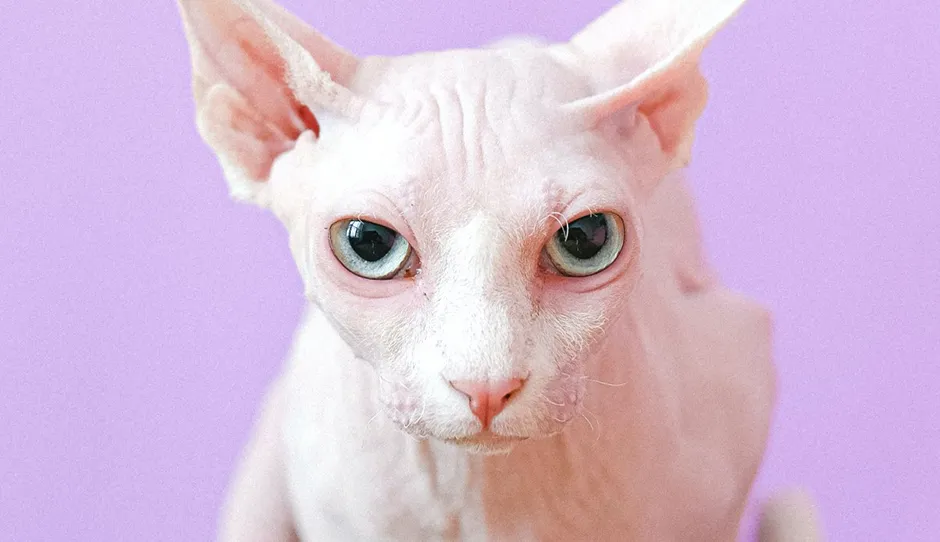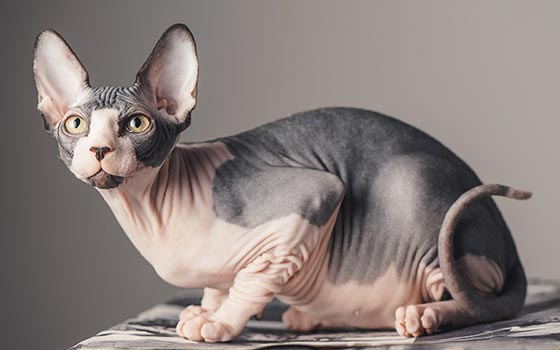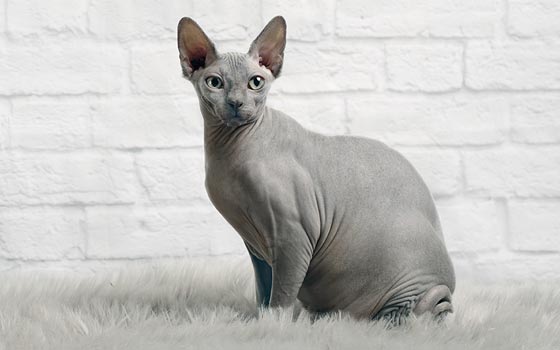Ready to help treat your pet to a healthy life?
Sphynx Cat Breed: Fun Facts, History & Health
By : Trupanion Staff | Updated Feb 1, 2024

One of the most recognizable cat breeds in the world is the Sphynx cat. Perhaps most famous for its hairless appearance, the Sphynx is beloved by families and individuals around the globe for its friendly demeanor and cuddly nature. But if you're debating whether or not to adopt a Sphynx cat into your family, it's important to get all the facts first.
This breed comes with a unique set of care needs and health concerns that you'll need to be on top of in order to provide your kitty with the best life possible. While cat insurance can go a long way in helping you be prepared, research into the breed is key. Fortunately, we've got your back with this extensive guide all about Sphynx cats!
Interesting facts about Sphynx cats
- Sphynx cats have average lifespans between 10 and 15 years.
- The Sphynx is one of the smaller cat breeds, weighing an average of just six to 12 pounds when fully grown.
- You’d expect a cat breed with the name Sphynx to be from Egypt, but in fact, this hairless breed originated in Canada. In the breed’s early years it was often referred to as the “Canadian Hairless,” “Moon Cat,” or “Moonstone.”
- According to the Cat Fanciers’ Association, the Sphynx is the 8th most popular cat breed.
- This hairless cat breed was ranked as the friendliest breed according to a study published in the Journal of Veterinary Behavior. The need to stay warm, something accomplished by sticking close to humans, is thought to be the main reason why the Sphynx is so happy with being handled.
- While known for their adorable round pot belly, it can be tough for a Sphynx to actually gain any weight due to their fast metabolism. They’ve always got an appetite and might eat you out of house and home.
- Think of a Sphynx as a very warm peach — while called a hairless cat, they actually have a layer of fuzz that feels like suede to the touch. But many Sphynxes don’t have any whiskers!
Sphynx cat breed details
Yes, the Sphynx cat is well-known for appearing to be bald all over. But that's not the only trait that helps this breed stand out as unique in the world of cat breeds.

Distinctive physical features
- Very large, bat-like ears
- Striking lemon-shaped eyes
- Thick paw pads and dexterous toes
The Sphynx can come in a variety of colors, even though it has no fur coat. The color of the skin shows what color their coat would have been, and the breed standard allows for any color and pattern. You might see a Sphynx in the recognizable white (which can be a bit pink), black, or tabby patterns, but some Sphynx might be a lavender color or have a mackerel tabby pattern.
Unique personality
The Sphynx is a curious and sociable cat, often described as being very dog-like because they love attention and do well with being handled. They revel in finding a nice, warm lap or curling up in bed with their owner to stay warm. Intelligent and curious, these kittens need attention and lots of play but are loyal and incredibly affectionate cats.
Because Sphynx cats are considered to be hairless, they should be kept exclusively indoors to protect them from cold temperatures and sunburn. They like to sunbathe in windowsills (as long as your windows provide UV protection, which most do), or on top of warm appliances and snuggle with their human companions for warmth. However, Sphynx kittens are also highly active and intelligent — a trait that they keep into adulthood. They like to explore vertical spaces (shelves, high perches, and other locations that provide them with a sense of height) and can keep themselves entertained with toys. But beware, if they are not provided with toys or opportunities to keep themselves occupied, they will seek out activities to stave off boredom (which could be the reason some consider them to be somewhat mischievous). Many cats of this breed will follow their humans around and can be considered a bit “needy” in terms of attention from their guardians.
Similar breeds to the Sphynx cat
- Peterbald
- Donskoy
- Minskin
- Elf Cat
History of the Sphynx
The Sphynx breed began in 1966 with a hairless kitten (named "Prune") born to a domestic shorthair. The kitten, named Prune, was used to establish the first attempt at creating a hairless breed. Since the hairless gene was a recessive gene, litters often resulted in both hairless and cats with fur, and the small gene pool being used for breeding resulted in many health complications. In 1971, the breed’s status was revoked by the Cat Fanciers’ Association due to worry about fertility, and the first attempt at creating a Sphynx breed was abandoned.
However, only a few years later, two naturally hairless kittens were born as strays in Minnesota and taken in by a cat breeder, who aptly dubbed them Dermis and Epidermis. Meanwhile back in Toronto, two female hairless kittens were born in separate litters, named Paloma and Punkie. It was these four cats that became the foundation of the Sphynx breed as we know it today.
Breeders crossed the new breed with the Devon Rex, American Shorthair, and Domestic Shorthair breeds to increase the size of the gene pool. These three breeds are still allowed in outcrossing when breeding the Sphynx cat, but the CFA plans to require all Sphynx kittens born after December 31st, 2023 to have only Sphynx parents in order to be considered purebred.

Behavior and training
Because Sphynx cats are friendly and outgoing, they get along well with other kittens, adult cats, pets and new people. Rough play with other pets should be avoided, however, because even unintentional scratches can result in skin injuries due to the lack of protective fur.
Exercise and mental enrichment needs
Sphynxes are a high energy breed that requires exercise to stay happy, healthy, and help prevent unwanted behavior. Luckily, they love to play with toys and are quite the climbers. Give them an outlet for their energy by providing them with plenty of high places to perch and jump and having lots of play sessions together.
The Sphynx is one of the most intelligent of any cat breed and, combined with their very playful kitten-like nature and high need for attention, requires mental enrichment to keep it happy and out of trouble. This breed was described as “part monkey, part dog, part child, and part cat” in an old French breed standard, and reflects the agility, attention-seeking, and devotion to its guardians that the Sphynx demonstrates. If the Sphynx is not provided with suitable enrichment activities, they will seek out its own entertainment, which may result in mischief. Rotate toys to keep them novel, and seek out enrichment activities that provide opportunities for learning and puzzle-solving, such as clicker-training and food-puzzles.
How to keep your pet Sphynx occupied
Boredom leads to discontent in pets, especially intelligent breeds like the Sphynx. Help your feline friend stay busy and live a well-rounded life by encouraging the following activities:
- Napping in warm spots, such as cat cubbies or heated cat beds.
- Climbing cat trees, cat shelves, and perching in locations up high.
- Playing with small toys, including learning how to “fetch”.
- Toys that move fast and far can be exciting - try wand toys, laser pointers, and some battery-operated toys.
- Agility training and obstacle courses (yes, cats can do them too!)
- Clicker-training to encourage new behaviors (such as giving high-fives or fist-bumps, and other “tricks”) and exploratory behavior (e.g., reward new actions to a novel object with a click and treat).
- Food puzzles that encourage problem-solving and manipulation. “Expert-forager” puzzles that have drawers that must be opened with a button, lever, or pull can be a good challenge!

Health and care tips
Like all cats, pure-bred or not, Sphynxes are prone to certain health conditions. An individual cat's risk varies due to both genetics and lifestyle (all the more reason to ensure your pet is living healthily and is protected with a good cat insurance plan).
That said, the Sphynx breed in general is at higher risk of some conditions compared to other breeds. These include (but may not be limited to) the following:
- Allergies
- Hypothermia
- Sunburn
- Skin conditions (everything from acne to eczema)
- Obesity and associated health risks
- Respiratory issues
- Eye problems
Coat care
Some have described the Sphynx as having a coat that feels like chamois leather. These felines are famously hairless, although they do have a velour-like fuzz covering their bodies. This fuzz is often more obviously on the nose and back of the ears. They may or may not have whiskers.
Due to their lack of fur, Sphynx cats lose body heat more readily than their furry counterparts. They frequently feel cold and need plenty of warm, cozy spots to retreat to. And, as mentioned above, they're also prone to skin conditions. This doesn't mean they're doomed to a life of itching and redness, of course, but you will need to do some more work as a responsible pet owner. Your cat requires routine care to remove wax, dirt, and sweat buildup. Many Sphynx cats benefit from regular baths because of this, but they will need to be dried and warmed up quickly afterward.
Sphynx cats in pop culture
Even if you don't personally know a Sphynx cat, there's a good chance you've seen one on TV or in the arms of celebrities!
Famous owners
- Kat Von D (Reality TV Star/Tattoo Artist)
- Steven Tyler (Singer)
- Jane Fryer (Journalist)
Famous Sphynx cats
- The Dark Lord is a social media celebrity hypnotizing his audience with the most muscular cat knees you’ve ever seen.
- A cat actor named "SGC Belfry Ted NudeGent" played Dr. Evil’s cat, Mr. Bigglesworth, from the movie Austin Powers International Man of Mystery.
